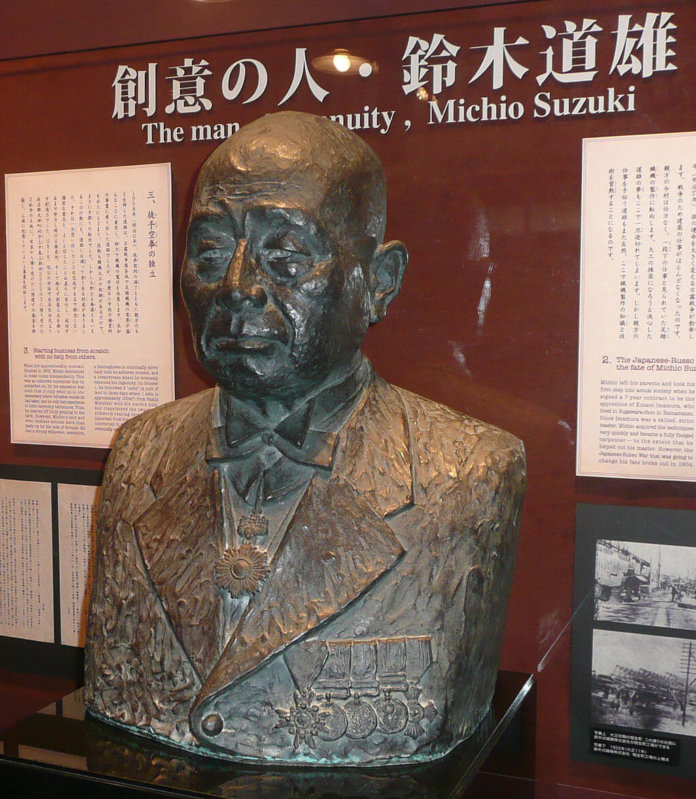
Suzuki Motor Corporation is one of the great success stories of Japan Inc; it is not only the ninth largest producer of automobiles in the world, but also a leading manufacturer of motors for motorcycles, marine engines, four-wheel vehicles, and more.
While Suzuki’s business model and products have evolved a great deal over the decades, one traditional tenet of has held true, and some believe that it is part of the reason why the company has maintained success for so long. The secret? Although Suzuki is a family-run business, the company has creatively toyed with the definition of ‘family’ by adopting skilled adults into their family so that the business can be passed onto them.
Suzuki’s Origins
Suzuki Corporation began in the small coastal village of Hamamatsu under Michio Suzuki. Originally named Suzuki Loom Works, the company specialized in building weaving looms for the silk industry, as well as weaving machines for export. While its first 30 years were spent in this industry, Suzuki would begin branching out into vehicle production, producing its first small car in 1939. This came to an abrupt halt when Imperial Japan began their brutal conquest of Asia during World War II, but the company resumed production in 1951 when a market crash in cotton made the loom business far less profitable. With Japan in great need of transportation options in the post-war era, Suzuki completely reoriented their business into automobiles.
The Suzuki Business Model
Part of understanding the success of Suzuki is breaking down its domestic and international business strategies, which take wildly different forms. Domestically, the company was faced with the task of breaking into a market already dominated by the likes of Honda and Toyota. As such, they began by producing engines and mopeds to sell motorized bicycles, a niche that that was far less competitive. Delivery vans and actual motorcycles would soon follow, and a Suzuki motorcycle’s victory in the 50cc-class Isle of Man race put their quality on the map.
Internationally, the company was far more aggressive. In the 1960’s and 70’s, Suzuki began seeking out markets similar to Japanese market conditions and actively began expanding in Indochina. In following decades, this would result in a joint venture with the Indian government called Maruti Udyog Ltd., as well an ever-growing partnership with General Motors in the United States.
Industry analysts attribute much of this growth to the current chairman and CEO of the company, Osamu Suzuki. He has been a long-term leader of the company, serving as president of Suzuki Motors since 1978. It was Suzuki who served as a “diplomat” of sorts during his early days at the company, traveling to areas such as Thailand, India, and Indonesia to negotiate and oversee the construction of Suzuki factories. He saw that small, fuel-efficient, affordable cars sold well in these markets, where gas was expensive but incomes were low.
In a 1998 interview with the Wall Street Journal, G. Richard Wagoner of General Motors was quoted as saying, “I’m not sure there’s anybody better at making low-cost cars. And it starts at the top with Osamu.” In addition to establishing an international presence, he was also known for fervently finding ways to cut costs and improve profits, personally visiting each factory on a yearly basis for up-close inspections.
The Role of Adult Adoption
For all this success, one may be surprised to hear that Osamu Suzuki is not a Suzuki by blood. Rather, his ascent into the company leadership was engineered by the Suzuki family when no suitable male heirs were available. Osamu was married to Shoko Suzuki, granddaughter of Michio Suzuki, and then adopted into the Suzuki family, taking the family name and by extension, a leadership role in the family conglomerate.
This seemingly unusual practice is far from uncommon in Japan, where, as we covered in this previous article, 98% of the adoptees are males from 25 to 30, for the purpose of adopting male heirs into family businesses without suitable sons to pass on the business.
Vikas Mehrotra, author of the paper “Adoptive Expectations: Rising Sons in Japanese Family Firms,” explains the modern-day version of this centuries-old practice in more detail: “You pick a candidate, an adoptee, preferably from Tokyo University, a smart person, and so on, and someone you have the opportunity to observe. And then you sort of do… what is called an omiai, which literally means ‘see marriage’, with one of your daughters… Then the person marries your daughter and is adopted into the family.”
Surprisingly, Osamu Suzuki is the fourth leader of Suzuki who was adopted into leadership, and even he himself had arranged for his successor to be his son in law, Hirotaka Ono, instead of his own biological son. However, Ono’s death from pancreatic cancer forced Suzuki to retake control as part of a four-person board including biological son Toshihiro Suzuki.
Although it may be a stretch to claim that these adult adoptions are the exclusive secret to the Suzuki success, it is safe to say that this unique culture certainly played an important role in the company’s longevity. As a Japanese proverb says, “You can’t choose your sons, but you can choose your son-in-law.”









